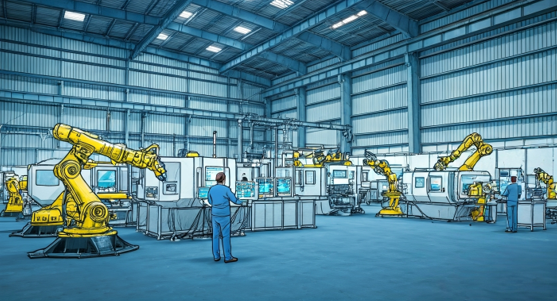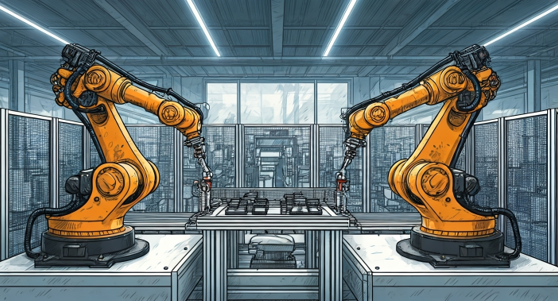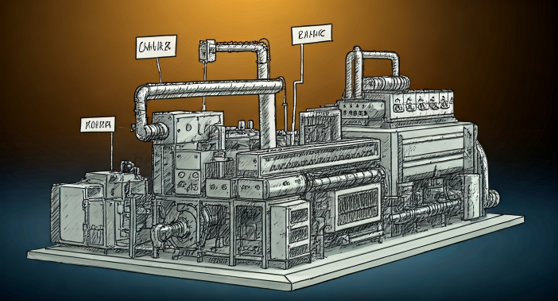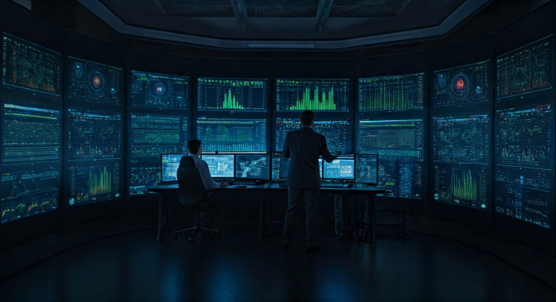Understanding Automatic Production: Benefits and Challenges
Understanding Automatic Production: Benefits and Challenges

Key Highlights
- Automatic production lines use advanced machinery, robotics, and sensors. This helps lower human intervention and makes the process smoother.
- By using automation, these systems can boost how much they make, do things more accurately, and keep the quality of every product the same.
- When companies bring in technology like artificial intelligence (AI) and the internet of things (IoT), they can work smarter. These systems help control the work better and can even tell when machines need repairs.
- Companies can have problems like high first-time setup costs. They also need to make sure their workers can learn new skills to work with these automated systems.
- Industries such as automotive, electronics, and consumer goods are able to get good results with automated production. They get more done in less time and with fewer mistakes.
- When businesses use automation, they not only spend less on labor. They also gain a clear competitive advantage, which helps them handle changing market conditions.
Now, let’s talk about what automatic production is and see how it shapes modern manufacturing.
Introduction
Automatic production brings big changes in the manufacturing process. It uses new technologies like automation, robotics, and advanced machinery to make each step faster and easier. By cutting down on human intervention, these machines help the production line run better, with more precision and fewer mistakes. When market conditions change and customer demand goes up, many industries use automation to stay ahead and have a competitive advantage.
With the help of artificial intelligence, sensors, and algorithms, companies can boost their production capacity and deliver better product quality. These tools make it easy to spot problems and fix them fast. This leads to less human error, lower labor costs, and better results for everyone.
The Complete Guide to Automatic Manufacturing System
Defining Automatic Production in Modern Manufacturing

Today’s automatic production uses the most modern machinery and smart algorithms. There is a big change happening in manufacturing because of new robotics and PLCs. These controllers help make production lines work in a smooth way. This setup cuts down the need for human intervention and brings down the number of human errors. There are many benefits when you use the internet of things and artificial intelligence, or AI, in these systems. These tools improve precision and let companies change as customer needs or market conditions shift.
With the right use of sensors and control systems, you can boost production capacity and get better product quality. Good machinery and strong controllers help give any business a clear competitive advantage. This is now the way production works and it looks to keep getting better over time.
Key Features of Automatic Production Systems
Automatic production systems bring together new machinery, smart robotics, and simple control systems to make the manufacturing process better. With sensors and easy-to-use algorithms, these systems can keep an eye on things, cut down on human intervention, and lower the chances of human errors. CNC and PLC technology help reach a higher level of precision, so product quality stays the same, even when market conditions and customer demand change. By adding the Internet of Things (IoT), the systems now let machines talk to each other and look at data from every part of the production line, making all the work flow together without trouble.
Evolution from Manual to Automated Processes
The move from doing jobs by hand to using automation has changed the way we make things. In the past, production lines needed a lot of human intervention, and this often caused human errors and made things less smooth. But as new technology came in, adding machinery and robotics made a big difference. These changes helped raise the production capacity and make things more exact.
Now, automation uses artificial intelligence and advanced control systems to make the work go faster, bring down labor costs, and help factories react quickly to what the customer demand is. This change makes the whole process better and helps businesses get a competitive advantage, even as market conditions keep changing.
Core Components of an Automatic Production Line

The main parts of a good automatic production line work together to make things faster and better. Machinery and robotics help a lot in this. They use smart algorithms and be very accurate, so there is not a lot of need for human intervention. Sensors and control systems keep an eye on everything in real time. This helps all parts talk to each other and keeps the production line running smooth. Software, like PLCs and AI, is also important. It makes the work quicker and cuts down on human errors. This boosts production capacity and helps get good product quality. As a result, you can do better in tough market conditions.
Machinery and Robotics
Advanced machinery and robotics are important in today’s automatic production systems. They help make the manufacturing process more precise and efficient. With the help of smart algorithms and control systems, these machines cut down on the need for human intervention. They also lower errors and help raise production capacity. The use of artificial intelligence makes things even better. It helps in predictive maintenance and lets the machines make real-time changes. With conveyor belts and sensors, automatic production lines run smoother. They can change quickly when market conditions shift. This helps businesses keep a competitive advantage.
Sensors, Control Systems, and Software Integration
An automatic production line uses advanced sensors that give real-time data about the whole manufacturing process. These sensors help to watch things like temperature and pressure closely. This keeps the production line working well and helps with quality control. The control systems, such as controllers and PLCs, use this information and work with special algorithms to make changes fast. This helps to cut down how much people have to do on the production line. Also, good software connections let the team study the data and plan for repairs before something breaks. This makes the production line run better and keep up with new market conditions and customer demand.
Major Benefits of Automatic Production
One big benefit of automation is that it makes a production line more productive and efficient. When there is less human intervention, the whole process can run all the time. This helps you get the most out of your production capacity and keep labor costs low. Another good thing is better product quality. Precision machinery and robotics help cut out human errors, so every item stays the same. Also, using sensors and AI gives real-time checks on what's being made. This means products can match customer demand and market conditions very accurately.
Boosting Productivity and Efficiency
Automatic production systems help to boost the output by cutting down on human intervention. This means there are fewer mistakes made at work. The use of smart machinery and robotics lets the process run smoothly. This helps make the production line work in a better way for more output.
The system uses things like algorithms and control systems for precision. This helps to make each workflow much simpler and increases the total production capacity.
The internet of things (IoT) is also put to use. With the IoT, all the machines talk to each other in the right way. This helps everything in the process work well together.
Because of all of these updates, organizations can deal with changes in market conditions in less time. They can also change to fit any new customer demand much faster. One more benefit is that the labor costs go down, since the work is handled by machines and robotics, not just people.
Enhancing Product Quality and Consistency
Reaching high product quality and staying consistent are very important in any automatic production line. When companies use up-to-date sensors and control systems, they can watch every step on the production line with great precision. This cuts down on human errors and keeps mistakes low. With the help of artificial intelligence and smart algorithms, real-time changes can be made to the line. This makes sure that every product lives up to high standards. Being this reliable helps grow customer trust and gives manufacturers a strong competitive advantage in tough market conditions.
Challenges and Limitations of Automated Production
High initial investment and setup costs can be a big problem for many who work in manufacturing. To move to an automatic production line, you often have to put a lot of money up front. This money goes to new machinery, robotics, and control systems. On top of that, there is the need for reskilling the workforce. You cannot ignore human factors, as managing people well when making these changes is just as important. Looking at what algorithms and sensors do to labor also helps avoid some problems. These things, along with changes in market conditions, can slow down how easy it is to add automation to the current production line.
High Initial Investment and Implementation Costs
Setting up automated production systems often needs a lot of money at the start. You have to pay for new machinery and robotics. There is also the cost to add advanced control systems that use AI, algorithms, and PLCs. This first spend also has to cover installation and setup, plus regular work to keep it running well. These costs can be tough for small or medium businesses to handle. Changing current production lines to fit automation can also mean extra spending. This makes it hard for some companies to keep up in changing market conditions.
Workforce Transition and Training Needs
Moving towards automatic production needs a careful plan for how employees will adjust and learn new things. As machinery and robotics become a bigger part of the production line, the people already working there have to pick up new skills. They need to know how to use advanced control systems and learn about AI and its algorithms. Keeping up with training helps lower the chance of human errors and helps workers feel better about what they do. When companies invest in training, they do more than just improve their production capacity. They also use human factors in a smart way, which helps bring automated systems into the production line more smoothly.
Industry Applications of Automatic Production
In many fields, automation helps to make everyday work much better. The automotive industry uses new robotics and AI to speed up the assembly lines. This helps to boost precision and cut down on human errors. The electronics sector also uses automated systems, so they can keep up with changing market conditions and still make sure the product quality is high. Food and beverage companies get a lot out of using conveyor belts and systems that work together. These help to keep up good and steady production capacity. All these uses show us that automation changes how we do manufacturing, and it gives a lot of benefits no matter what the market conditions are.
Automotive and Electronics Sectors
The automotive and electronics industries use a lot of automatic production. This helps to make work faster and keeps up with what customers want. By using machinery and robotics, they can make the manufacturing process smoother and have less human intervention. Sensors, AI, algorithms, and control systems work together to make sure there is more precision on the production lines. Conveyor belts also help everything move well and keep the work running smoothly. When market conditions change, being able to shift production capacity quickly is a big help. This gives companies a good competitive advantage. It helps boost product quality and keeps things stable in these busy and fast-moving fields.
Food, Beverage, and Consumer Goods
Bringing automatic production systems into the food, beverage, and consumer goods industries helps companies do things faster and at a bigger scale. When you use advanced robotics, CNC machinery, sensors, and controllers, the production lines can keep up with growing customer demand. They can do this while also keeping product quality high.
Sensors and PLC controllers let people have better control. This means there are fewer human errors and lower labor costs. Using artificial intelligence in these systems lets you watch your processes closely, so it's easy to make quick changes if market conditions shift.
All these tools working together help improve production capacity. They also give a business a strong competitive advantage in today’s fast-changing world.
Conclusion
The move to automatic production is changing the way things get made. It brings both speed and precision to the job. At first, there can be costs and the people who work there may need more training. But over time, this can help a company make more products and make them better. When new things like robotics and artificial intelligence get used, there is even more room to do things well. Companies that use these tools can keep their competitive advantage. They can also keep up with changing market conditions and what customers want. By doing this, they set themselves up for a more forward-thinking and better way to make things.
Frequently Asked Questions
What is the difference between automated and manual production?
Automated production uses machinery and technology to do jobs with very little human intervention. This helps to make things faster and keeps results the same each time. On the other hand, manual production depends on people doing the work. This can cause the results and how fast work gets done to change from time to time. Which method to use will depend on what the manufacturing needs are.
How does automation affect employment in manufacturing?
Automation in manufacturing can mean that some jobs are lost. This is because the work gets done faster and there is less need for people. But, automation also brings some new jobs that focus on using and taking care of the technology. It is important for companies to find a balance between these changes. They have to help people get ready for the new jobs and make sure the team learns new skills that match what the industry now needs.
What industries benefit most from automatic production?
Industries like the automotive, electronics, and food and beverage fields get a lot from automation. They use it to do tasks faster and keep things the same each time. It also helps make work simpler. This leads to better results for them in the market, and they stay ahead of others.
What are common challenges faced when implementing automation?
Putting automation into place can be hard for some reasons. The start-up cost may be high. The mix of new tools can be complex, and many people worry that their jobs may be at risk. On top of this, it is important to take care of the new systems over time. Training people on the new way to work can also take effort and time. All these things can slow down how fast a company moves to automation.
Can small businesses adopt automatic production systems?
Yes, small businesses can use automatic production systems. This is possible because there are now technologies and tools that are flexible and cost less. These systems help to make work faster and more organized. They also help you make products that are always the same quality. This lets small businesses keep up and compete with others as the market changes quickly.
What are the key benefits of automatic production systems?
Automatic production systems enhance efficiency, reduce labor costs, and ensure consistent product quality. They minimize human error, increase output speed, and provide better inventory management. Additionally, these systems offer scalability and flexibility, allowing businesses to adapt quickly to market demands while maintaining high operational standards and reducing overall production costs.



